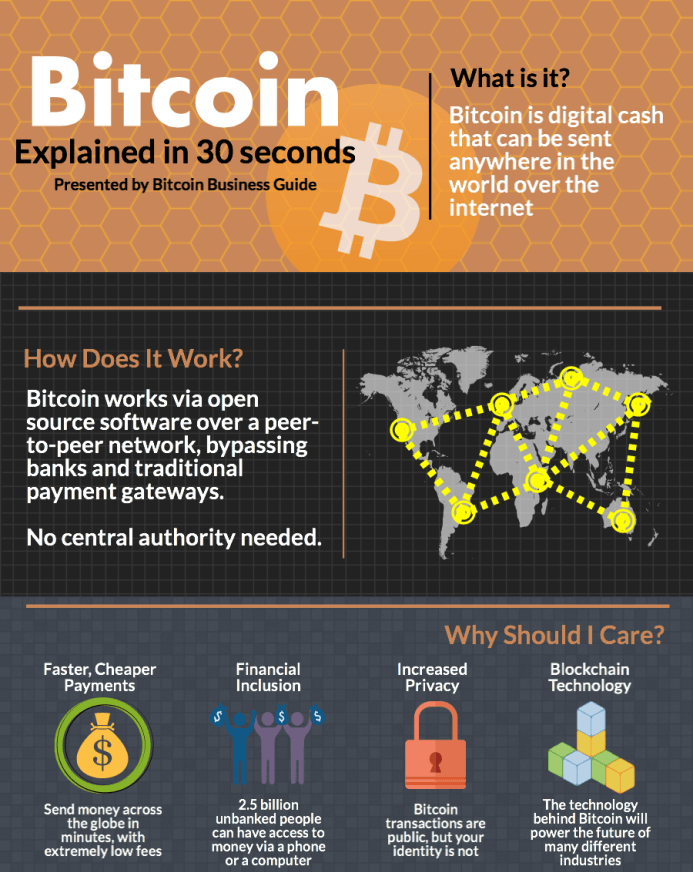Information Every Investor Should Know
What is Cryptocurrency?
Cryptocurrencies, sometimes called virtual currencies, digital cash, or tokens are not really like U.S. dollars. Cryptocurrencies use cryptographic* techniques to control the generation of currencies and verification of all transactions that occur. Cryptography is simply “the computerized encoding and decoding of information”.
Most Cryptocurrencies have the following features:
They’re irreversible. After you send a cryptocurrency and the network has confirmed it, the transaction can not be undone.
They’re fast and globally accessible. Transactions are broadcasted across the network immediately and can be confirmed in a couple of minutes or even seconds.
They’re built to be very secure. Cryptocurrencies use the latest cryptographic techniques, but they’re in early development.
They have a controlled supply limited by the network.
What is Bitcoin?
Few people know, but cryptocurrencies emerged as a side product of another invention. Satoshi Nakamoto, the unknown inventor of Bitcoin, the first and most important cryptocurrency, never actually intended to invent a currency, but rather a decentralized system used to send and receive instant payments.
“A purely peer-to-peer version of electronic cash would allow online payments to be sent directly from one party to another without going through a financial institution”
-Satoshi Nakamoto 2008
The single most important part of Satoshi‘s invention was that he found a way to build a decentralized digital cash system.
Live Bitcoin Price Ticker
One of the hardest parts of implementing a digital payment system is making sure that nobody spends the same money more than once. Traditionally, this is done by having a trusted central authority (like PayPal) that verifies all of the transactions.
In a decentralized network, you don‘t need this trusted authority. Every transaction is validated before finalized to prevent double spending. This seemed to be an impossible task before Satoshi came around. In the nineties, there were many attempts to create digital money, but they all failed.
Satoshi changed the world by proving this was possible.
"… after more than a decade of failed Trusted Third Party based systems (Digicash, etc), they see it as a lost cause. I hope they can make the distinction, that this is the first time I know of that we’re trying a non-trust based system." – Satoshi Nakamoto in an E-Mail to Dustin Trammell
After seeing all the failures of trusted third party systems, Satoshi successfully created a decentralized payment system. This led to the birth of cryptocurrency.
In case you still don't understand what bitcoin is check out the info-graphic below
What is Ethereum?
Ethereum is a decentralized public blockchain network. Although there are some significant technical differences between the two, the most important to note is that Bitcoin and Ethereum differ substantially in purpose and capability. Bitcoin offers just one application of blockchain technology; a peer to peer electronic cash system that enables online Bitcoin payments. While the Bitcoin blockchain is used to track ownership of digital currency (bitcoins), the Ethereum blockchain focuses on running the programming code of any decentralized application.
Ethereum was crowdfunded in the year of 2014 and was developed by a Swiss nonprofit organization, the Ethereum Foundation with some of the smartest people in the world. Vitalik Buterin, a programmer from Toronto, is credited with being the main mastermind behind Ethereum, and was even featured two years in a row on Forbes 40 under 40 list. Due to these advancements, there are two terms you will see often when reading about cryptocurrencies.
To put it in simple words, Ethereum is a decentralized platform for running smart contracts. Smart contracts are applications that run just the way they are programmed, with zero possibility of any censorship, fraud, or third party interference.
Smart Contracts
As the name suggests, these are contracts but not in the way we normally think of a contract. A smart contract is a computer protocol/program, which automatically executes the contractual part corresponding to the condition that is fulfilled. With smart contracts, you are looking at an incorruptible system of enforcing contracts, thus eliminating the risks of delayed payments and bringing down the risk of non-performance by over 80%.
With Ethereum, anyone can design and use his or her own cryptocurrency, which can further be used either as a currency or to represent a share or any asset amongst other things. With a standard API, the contract from these tokens will work with any kind of wallet, contracts or even exchanges. It can also help projects get funding through smart contracts.
Blockchain
The Blockchain, being the most talked-about subject in Ethereum and other cryptocurrencies like Bitcoin, is nothing more than a distributed database. One analogy used is an excel spreadsheet that is distributed among several users. If one user makes a change, all the other users can see it as well as soon as the change is made. No other user can undo the changes made. Blockchains have data records, grow continuously and are protected against any form of revision and tampering using cryptography encryption. A blockchain, unlike traditional server architecture, does not go down if a single node is compromised or goes offline. The users data is private and apps remain safe and decentralized; working just the way the Internet was intended to do.
Recommended Pages to Continue Learning






